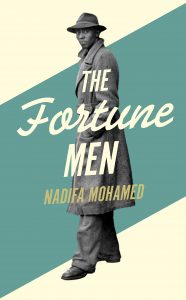Nadifa Mohamed: The Fortune Men (March 2025)
 This is a true story in the form of a novel about a miscarriage of justice. In Tiger Bay in 1952, 29 year old Mahmood Mattan, a Somali ex-merchant seaman, was wrongfully convicted and hanged for the robbery and murder of shopkeeper Lily Volpert, renamed Violet Volacki in the book.
This is a true story in the form of a novel about a miscarriage of justice. In Tiger Bay in 1952, 29 year old Mahmood Mattan, a Somali ex-merchant seaman, was wrongfully convicted and hanged for the robbery and murder of shopkeeper Lily Volpert, renamed Violet Volacki in the book.
He was a convicted petty thief and gambler, well-known to the police, but had no history of violence and this was a brutal murder with the victim having her throat cut. Tiger Bay was a dangerous area with a lawless reputation so there was no shortage of people willing to kill for money.
Violet’s sister Diana and niece Gracie saw a man, possibly a Somali, loitering outside the shop at 8pm, just before Violet reopened the store for someone she assumed was one of her regular customers. They were adamant in their statement to the police and at the trial that he bore no resemblance to Mahmood Mattan. The officer in charge was not prepared to consider anything that could jeopardise his case against the accused.
Before Mattan’s arrest the Volacki family had, unwisely in our view, offered a substantial reward for anyone who provided evidence that helped with a conviction. So greed, combined with the fact that Mattan had enemies who could easily be coerced by the police to perjure themselves, conspired against a fair trial.
Mahmood did have an alibi, though it was contradicted, and was firmly confident both in the British judiciary system and in his religious faith that if he simply told the truth he would be released and financially compensated.
His solicitor took a dislike to Mahmood, who he found rude and arrogant but, surely, he must have had worse clients than Mahmood to deal with?
The jury took slightly over an hour and a half to find Mahmood Mattan guilty despite lack of physical evidence. Shockingly, his own defence counsel called him a “half child of nature, a semi-civilised savage” who had told the court foolish lies.
There was a chapter relating Mahmood’s eventful and adventurous life which helped the reader understand him more. Some of the group, however, considered this section overlong and jarring to the narrative.
Mahmood had a wife, Laura, and two sons. Their marriage was troubled and they were living separately at the time of the crime but there was love in this family. A mixed marriage was strongly disapproved at the time. She only learned of his execution after the event when she came to visit him. Laura fought for over forty years to clear Mahmood’s name but, sadly, one son died on a beach, an open verdict given at the inquest, and the other died alone surrounded by empty bottles.
There was a suggestion that his family and their story was not given enough prominence and we needed to learn more about the struggle for justice for Mahmood.
Often the victim and their family are overlooked in real and fictional stories about murder but in the book we see the Volacki family’s suffering. As a Jewish family they had already lost so many people in their lives and, with the war ending only seven years ago, they were still only just receiving dreadful news.
The Ruth Ellis case is currently being re-examined in drama and documentary form and we saw some similarities in the two cases. Both Ruth Ellis and Mahmood Mattan were pre-judged on grounds of race in his case, gender on hers, and lack of worth as human beings.
A sad story but one that deserved to be told.
3/5
